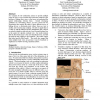Free Online Productivity Tools
i2Speak
i2Symbol
i2OCR
iTex2Img
iWeb2Print
iWeb2Shot
i2Type
iPdf2Split
iPdf2Merge
i2Bopomofo
i2Arabic
i2Style
i2Image
i2PDF
iLatex2Rtf
Sci2ools
SI3D
2003
ACM
2003
ACM
An evaluation of methods for linking 3D views
It is common for 3D visualization systems to provide multiple points of view to a user, but there have been many solutions to the problem of linking these views so that users can understand the spatial relationships between them. Toward developing guidelines for view-linking devices, we have carried out two experiments that compare the utility of three different classes of linking devices: a directional proxy, tethers from one view to another, and a track-up map coupling. The task we apply them to is what we call the multi-perspective identification task: subjects are asked to identify an item seen in a local, forward-looking view in the context of a global, overhead view. Our results indicate that the directional proxy is the most beneficial device, and that the track-up map coupling is also beneficial. The results suggest that tethers provide little benefit. The results also suggest that when multiple local views are present, it may be beneficial to emphasize one window as being of ...
| Added | 05 Jul 2010 |
| Updated | 05 Jul 2010 |
| Type | Conference |
| Year | 2003 |
| Where | SI3D |
| Authors | Matthew Plumlee, Colin Ware |
Comments (0)

